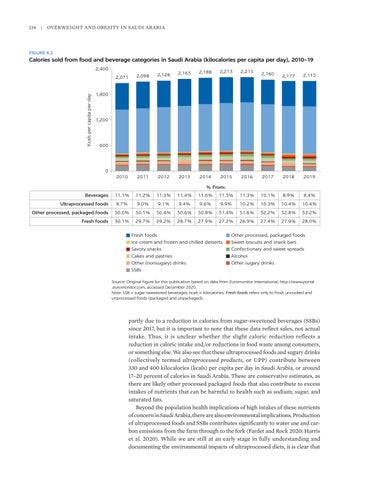134
|
Overweight and Obesity in Saudi Arabia
FIGURE 8.2
Calories sold from food and beverage categories in Saudi Arabia (kilocalories per capita per day), 2010–19
Kcals per capita per day
2,400 2,098
2,128
2,165
2,188
2,213
2,215
2,071
2010
2011
2012
2013
2014
2015
2016
2,160
2,177
2,115
2017
2018
2019
1,800
1,200
600
0 % From: Beverages Ultraprocessed foods
11.1%
11.2%
11.3%
11.4%
11.6%
11.5%
11.3%
10.1%
8.9%
8.4%
8.7%
9.0%
9.1%
9.4%
9.6%
9.9%
10.2%
10.3%
10.4%
10.4%
Other processed, packaged foods
50.0%
50.1%
50.4%
50.6%
50.9%
51.4%
51.6%
52.2%
52.8%
53.2%
Fresh foods
30.1%
29.7%
29.2%
28.7%
27.9%
27.2%
26.9%
27.4%
27.9%
28.0%
Fresh foods Ice cream and frozen and chilled desserts Savory snacks Cakes and pastries Other (nonsugary) drinks SSBs
Other processed, packaged foods Sweet biscuits and snack bars Confectionary and sweet spreads Alcohol Other sugary drinks
Source: Original figure for this publication based on data from Euromonitor International, http://www.portal .euromonitor.com, accessed December 2020. Note: SSB = sugar-sweetened beverages; kcals = kilocalories. Fresh foods refers only to fresh uncooked and unprocessed foods (packaged and unpackaged).
partly due to a reduction in calories from sugar-sweetened beverages (SSBs) since 2017, but it is important to note that these data reflect sales, not actual intake. Thus, it is unclear whether the slight caloric reduction reflects a reduction in caloric intake and/or reductions in food waste among consumers, or something else. We also see that these ultraprocessed foods and sugary drinks (collectively termed ultraprocessed products, or UPP) contribute between 330 and 400 kilocalories (kcals) per capita per day in Saudi Arabia, or around 17–20 percent of calories in Saudi Arabia. These are conservative estimates, as there are likely other processed packaged foods that also contribute to excess intakes of nutrients that can be harmful to health such as sodium, sugar, and saturated fats. Beyond the population health implications of high intakes of these nutrients of concern in Saudi Arabia, there are also environmental implications. Production of ultraprocessed foods and SSBs contributes significantly to water use and carbon emissions from the farm through to the fork (Fardet and Rock 2020; Harris et al. 2020). While we are still at an early stage in fully understanding and documenting the environmental impacts of ultraprocessed diets, it is clear that






